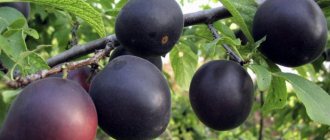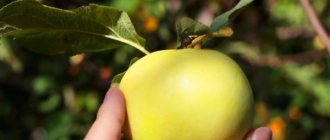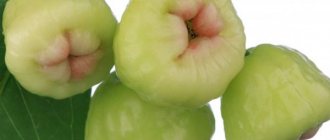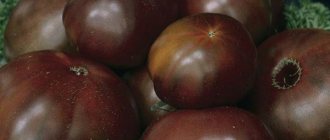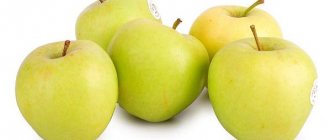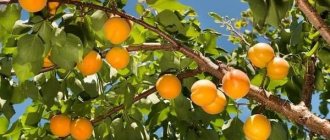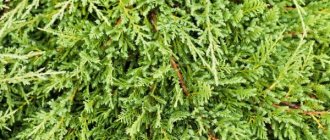Description of the apricot variety - Black Prince
Dark purple apricots have recently begun to be grown in garden plots. The advantages of the hybrid species are that they tolerate winters more easily and can grow in the conditions of central Russia.
The fruits of the Black Prince are quite large - weighing up to 80 g. After ripening, they become dark burgundy or almost brown. The flesh of the Black Prince is juicy and bright red-golden in color. Apricots taste sweet with slight sourness and tartness. It combines the taste of apricot, peach and plum. The aroma is familiar apricot. The pit cannot be separated from the pulp.
After ripening, the fruits may fall off, so the Black Prince is picked slightly unripe.
But keep in mind that apricots picked early do not ripen.
All nutrients, sugars and vitamins come through the stalk, plus they need sun. Without this, the picked apricots will not ripen, although they may become softer. You need to pick fruits that are ripe, but not yet beginning to become soft on the branch, otherwise they will rot. You can determine the ripeness of an apricot on the tree by its softness. Ripe fruits become darker in color and slightly less firm than green ones. During this period, it is important to quickly collect them, otherwise they will quickly become limp and fall off.
You can pick apricots from the tree from the end of July; in warm areas, the period extends until the end of August.
The yield of the variety is above average. Apricots begin to bear fruit after 3-4 years of growth. On average, an apricot tree lives up to 100 years, but active fruiting lasts up to 20-30 years.
Advantages and disadvantages of the variety
Despite their unusual appearance, black apricots are quickly gaining popularity. This can largely be explained by their multiple advantages, including:
- Late flowering, thanks to which the plant is not vulnerable in the event of late cold snaps in the spring.
- The compactness of the plants makes them easy to care for.
- High resistance to major diseases and pests, including moniliosis and cytosporosis, which often affect stone fruits.
- Excellent taste of the fruit. Of course, they are somewhat different from the usual apricot in that they have a tart note. But overall they are very pleasant and original.
In fairness, it is necessary to mention some disadvantages. The fact is that if you do not harvest the crop on time, the skin of the fruit begins to crack, as a result of which they lose their appearance, and transportation is complicated. In addition, in cold climates, gardeners must take care of covering the tree trunk area to avoid freezing of the roots. One way or another, such an original hybrid apricot is very interesting to modern gardeners. With proper care, trees produce high yields, requiring a minimum investment of effort and time.
Article Rating
Advantages and disadvantages
Many summer residents who planted the Black Prince and reaped the first harvest were satisfied with the varietal characteristics of the apricot. But before choosing a crop for your garden, you need to know about all the pros and cons of the variety.
The benefits include:
- The variety is unpretentious in care and planting;
- It has excellent frost resistance and can withstand midland winters;
- The fruits are large;
- Pleasant taste;
- High resistance to diseases such as: moniliosis, klyasterosporiosis;
- Excellent decorative qualities in spring during flowering and in summer when fruits ripen;
- Thanks to late flowering, flowers and ovaries do not die due to the return of spring frosts.
Apricot flowers resemble snow.
But it is worth taking into account a number of disadvantages:
- Poor transportability. The fruits quickly wrinkle, spoil, and do not last.
- Overripe apricots have cracked skin.
- Despite its winter hardiness, the plant must be covered and mulched during the winter.
- In the sixth year of growth, thorns appear, which complicate the collection and cultivation of the variety in the garden.
Does the variety need a pollinator?
The variety is considered self-pollinating, although gardeners have differing opinions. Some believe that the Black Prince apricot is self-fertile, and pollinators are needed for a single tree to bear fruit. But in a typical plot there are always other fruit trees that can become pollinators. These can be plums, apple trees, peaches, cherry plums and others. All of them are suitable for pollinating a hybrid.
The apricot variety Son of the Red-cheeked is also suitable for pollination
We recommend turning your attention to another hybrid, but now a hybrid of apricot, plum and prsik - Sharafugu.
How to plant an apricot
The principles of growing the Black Prince are practically no different from growing other varieties of apricots. This is an unpretentious plant, but for the longevity of the tree and high productivity there are several simple recommendations and tips for growing it.
It is better to plant apricots in the spring before the buds begin to swell and form. In the fall, the plant will not have time to take root and adapt. An exception may be: Plant in cloudy and rainy weather. When planted in spring, the survival rate of seedlings is almost 100%.
If at the time of planting the seedling already has leaves and branches, shorten them by ⅓. This will delay the evaporation of moisture, making it easier for the plant to adapt and take root.
Selection of quality seedlings
The results of cultivation depend on the quality of the selected planting material. Seedlings must be without buds or leaves. If they have already appeared, remove them or trim them by ⅓. Inspect the plant for diseases and pests.
You should buy seedlings only from trusted nurseries or gardening stores. If you buy secondhand, there is a high probability of purchasing an infected plant or the wrong variety.
Selecting a location
This is a sun-loving plant. Plant the Black Prince in a well-lit part of the garden, but not in the full sun. The place must be protected from drafts. The variety is unpretentious to the quality of the soil, but the soil should not be swampy, low-lying or too moist. Choose a location away from groundwater.
Landing technology
One plant requires an area of 5 square meters. m. Therefore, if you plant apricots nearby, keep a distance of 3-4 m around.
When planting, dig a hole measuring 80x80 cm, up to 1 m deep. Add humus or rotted manure, drainage made of broken bricks, pebbles or expanded clay to the bottom. Place a stake in the middle to secure the seedling. The excavated soil is mixed with ash or peat and filled into half the hole.
Prepare the pit in the fall, leave it until spring so that it settles.
Plant the plant in the spring when the weather becomes consistently warm and the threat of another frost has passed.
Dip apricot roots into ash, a growth-stimulating solution, and spread them on the surface of the soil in a hole. The root collar should be 5 cm higher than the soil level. How to find out where the root collar is, read here.
After planting, cover with soil, tie up and water.
Using barrels for planting
If in your area the groundwater lies too close to the surface, experts recommend planting seedlings in barrels dug into the ground (with the bottom cut out). In this case, the planting hole is first prepared and covered with pebbles (or other drainage).
Then the hole should be filled with soil substrate, after which the barrel is installed so that it rises half a meter above the ground. A tree planted in this way is reliably protected from rising groundwater in the spring and excess snow at the base of the trunk in winter.
Variety care
Caring for the variety is simple. A few tips will help you get a rich and tasty harvest.
Watering
Apricot Black Prince does not like drought, but it also cannot tolerate excessive moisture. Water more often, but not too much. During the summer months, water less frequently, depending on the weather. If the weather is too hot and there is not enough rain, then increase your watering frequency.
In the fall, it is also worth reducing watering so that the plants can calmly prepare for the winter, since watering stimulates additional growth. In this case, the plant will not have time to adapt to winter.
Fertilizer application
It is important to know about the peculiarity of the variety - the Black Prince apricot does not like nitrogen fertilizers. In general, he does not tolerate excess feeding. Therefore, fertilizing should be done sparingly and rarely.
In the spring you can add a little organic matter, in the summer - minerals, with phosphorus and potassium. Dosages should be minimal. But it is not advisable to fertilize in the fall so that the plant prepares for winter.
How to trim an apricot correctly
The Black Prince will not have to be circumcised often. The plant has a small crown without thickening. Sanitary pruning of apricot is carried out in spring or autumn. At this time, you can see which branches are infected, damaged, broken, withered or old.
In the spring, diseased, frozen branches are removed, and in the fall, broken and dried branches are removed so that it is easier for the plant to survive the winter and they do not take away nutrients.
Perform formative pruning as needed. Cut branches that grow in the wrong direction, inwards, downwards, as well as those that interfere with neighboring ones, or that are weak.
Preparing for winter
The Black Prince apricot variety tolerates frost well, but before winter it is recommended to mulch the ground around with peat or non-woven material. The root system can freeze out in severe frosts. Also whiten the trunk to protect the plant from hares.
Recommendations for cultivation
A description of the activities for growing this “crowned royalty” will not take up much space: this crop does not cause any difficulties. Agricultural technology includes standard procedures, but some points are worth paying attention to.
- Each seedling requires an area of at least 5 m², sunny and protected from wind and draft.
- Apricot is undemanding when it comes to soil; the main thing is to prevent groundwater from being close to it, otherwise the roots will get wet.
- The pit is prepared in the fall - 80x80x80 cm with drainage to prevent stagnant moisture. Planting is carried out in a mixture of earth, peat and sand in equal proportions with the addition of wood ash.
- It is necessary to observe the measure in watering and fertilizing. The soil under the apricot should be moistened frequently, but in moderation. Excess fertilizers, especially with nitrogen, are contraindicated for the Black Prince. Therefore, during the growing season, a little organic matter is added to the apricot, and during the formation of the crop, potassium and phosphorus fertilizers are applied.
- Due to the low density of the crown, only sanitary pruning of broken, diseased or frozen branches is sufficient for apricots. The crown is formed 3-4 years from the moment of planting, then only the weak shoots growing inwards are removed.
According to reviews from experienced gardeners and ordinary summer residents who have already appreciated the merits of this apricot, it will bear fruit even in lean years, even a beginner can grow it, and the taste suits absolutely everyone.
Diseases of the Black Prince variety
The plant is resistant to some diseases, but it is worth taking additional preventive measures. To do this, remove fallen leaves and fruits, branches. Clean the tree trunk area in spring and autumn, as fungi and pest larvae overwinter in old leaves.
It is recommended to dig up the soil around it, and in the spring, before the tree awakens, mulch it with non-woven material or film so that larvae and insects that have overwintered in the soil do not move onto the tree.
At the first sign of infestation or pest damage, treat with fungicides and insecticides.
Clusterosporiasis (hole spotting)
The disease is common in stone fruits. The Black Prince variety is resistant to the disease, but in cool and humid weather the spores become more active and infect the plant with weakened immunity.
Clusterosporiosis of apricot
Fungi develop on all parts of the tree: leaves, shoots, buds and flowers, even branches. The affected areas become covered with spots, then they darken and become covered with holes. Buds and flowers fall off.
Fungal spores are resistant to various weather conditions, so they live for years. The disease must be controlled using fungicides:
- Captana,
- Soon,
- Signuma,
- Horus,
- Tsineba.
Spraying is carried out in the spring before buds form.
Moniliosis (monilial burn)
The disease develops in cool and damp climates. It appears as brown spots on the leaves. Flowers dry up and fall off. The trunk and branches begin to crack and gum is released.
The disease appears during fruit ripening. The spores spread to the fruits, which become deformed and rot right on the branches.
For prevention, treat the plant in the spring before bud formation with fungicides Horus and Urea, Bordeaux mixture, soap solution, and iron sulfate.
Scab
Scab appears as dark spots on fruits and leaves. Apricots decrease in size, flowers also become rarer, dry out and fall off.
If preventive measures were not carried out on time or did not help, then you can fight the disease with the help of fungicides:
- Soon,
- Fitosporina,
- Khoma,
- Topsina-M.
Dilute the preparations according to the instructions, spray in the spring before buds appear or in the fall after harvesting.
Features of agricultural technology
The Black Prince is not one of the particularly capricious varieties of apricots. Even a novice gardener can easily cope with its cultivation. To get a good result, he just needs to follow the fairly simple rules of agricultural technology for this crop.
Planting and preparation for it
Black Prince, like many other apricot varieties, thrives in well-lit areas protected from the wind. It should not be planted in lowlands or areas with high groundwater levels. Excessive moisture often leads to rotting of the roots, which can cause the death of the entire plant.
The Black Prince is undemanding when it comes to soil, but it grows best on loose, fertile soils with a slightly alkaline reaction. Only owners of plots with highly saline or acidified soil will not be able to grow this variety. In most regions of Russia, apricots are planted in open ground in the spring after stable above-zero temperatures have been established. Gardeners in Crimea, Krasnodar Territory, Volgograd and Rostov regions often practice autumn planting. It usually falls at the end of October-beginning of November.
Gardeners who decide to become owners of the Black Prince need to pay special attention to planting material. In order to make money on the sale of new products that are in high demand, some traders pass off long-known varieties as them, and sometimes even wild, ungrafted plants. To avoid becoming a victim of scammers, it is better to purchase seedlings from specialized garden centers and large nurseries. Ideally, the seller can show the mother plant from which the cuttings were obtained.
The hole for planting the Black Prince is prepared at least a month before planting. If this process is carried out in the spring, then all preparatory work should be completed in the fall. For a two-year-old Black Prince seedling, a hole measuring 70 x 70 x 70 cm is sufficient. A drainage layer is placed on its bottom to prevent stagnation of water at the roots. Then the excavated soil mixed with 500 g of complex mineral fertilizer is placed in the hole. It can be replaced with several buckets of well-rotted manure. It would also be useful to use wood ash, which serves as an excellent source of potassium.
Broken bricks, clay shards, crushed stone, expanded clay and other similar materials can be used as drainage
The actual landing of the Black Prince looks like this:
- A day before planting, the cuttings are soaked in warm water, to which, if desired, you can add any biostimulant and potassium permanganate, which has an excellent disinfectant effect. The color of the resulting solution should be light pink. A higher concentration of potassium permanganate can burn the tender apricot roots.
- A small mound is formed from the soil with which the hole is filled and sprinkled with a thin layer of fertile soil. This is necessary in order to protect young roots from contact with fertilizer.
- Stepping back a little from the center of the mound, install a peg 1.5 times higher than the seedling. Subsequently, it will serve as a support for the young plant.
- The Black Prince seedling is placed in the center of the mound, the roots are straightened and carefully, in small portions, covered with earth. After the hole is completely filled with earth, the root collar should rise above its level by 5–7 cm.
- The tree trunk circle is carefully compacted and watered with 2-3 buckets of warm water. To retain moisture, it is mulched with sawdust, grass clippings or straw.
- The tree is tied securely, but not very tightly, to the support.
- To facilitate rooting, the seedling is shortened by a third and all its leaves are torn off. If necessary, it can be protected from too bright sunlight with any white agrofibre.
Black Prince is a rather unpretentious variety. Caring for it includes:
- watering,
- application of fertilizers,
- weeding and loosening the tree trunk circle,
- pruning,
- combating diseases and pests.
In addition, gardeners from regions with a pronounced change of seasons need to pay attention to preparing the plant for wintering.
Watering and fertilizing
Apricot Black Prince especially needs watering during intensive shoot growth, flowering and ovary formation. During these periods, it is watered at least once a week. At the same time, at least 60–80 liters of warm water are consumed per adult plant. Watering is best done in the evening, immediately after sunset.
Apricots are watered rarely but abundantly
Immediately after watering, the tree trunk circle is loosened well and, if necessary, the mulch layer is renewed. This helps prevent the soil from drying out quickly. A month before harvest, watering is stopped. Excess moisture during fruit ripening can lead to a significant deterioration in their taste and cracking. A fruit-bearing apricot usually has enough moisture obtained from natural precipitation. Only in regions with an arid climate does it require mandatory autumn moisture-recharging watering. During this process, at least 70 liters of water are consumed under one tree.
To feed the Black Prince, both mineral and organic fertilizers are used. When applying them, moderation must be observed. This variety reacts extremely negatively to excess nutrients. An overdose of nitrogen is especially dangerous for it, which can cause a complete absence of fruits. The first feeding is carried out no earlier than the second year of growing the Black Prince. As a rule, it includes two stages:
- In the spring, well-rotted compost or humus is added to the apricot tree trunk (no more than 7 buckets per adult plant).
- During fruit formation, plants are fed with mineral fertilizers containing large amounts of potassium and phosphorus (about 15 grams of potassium chloride and 12 grams of superphosphate per 1 sq. m of trunk circle).
Read also: Kuban black: features of growing black apricot
The varietal feature of the Black Prince is its compact crown size, so it does not require frequent pruning. Some gardeners form the plant in the form of a bush, as tall as a person. This greatly simplifies apricot care and harvesting. Most often, this method of pruning is used in northern regions, where a low-growing bush has a better chance of successfully wintering than a tree. To form a tiered crown, immediately after planting, the cuttings are shortened by a third and all vertical shoots are removed. In subsequent years, when pruning, gardeners adjust the height of the plant to their liking, shortening the central conductor and upward-growing branches. As a result of such pruning, the main fruiting goes to the side branches, harvesting from which does not require much effort.
Video: how to trim an apricot correctly
Mature plants with an already formed crown require annual sanitary pruning. During it, old, dry and diseased branches are removed. The best time for sanitary pruning is early spring, before active sap flow begins.
Preparing for winter
Despite the rather high frost resistance of the Black Prince compared to other apricot varieties, it needs preparation for wintering. First of all, the gardener needs to clear the tree trunk circle of debris and fallen leaves. Then the lower part of the trunk is whitened with a solution of slaked lime with the addition of office glue and copper sulfate. This will save the tender bark of the Black Prince from the attacks of rodents.
To protect the root system from severe frosts, the tree trunk circle is covered with humus. A mound 20–30 cm high is formed from it near the trunk. Young plants can be entirely covered with cardboard boxes or wrapped in burlap and agrofibre. It is important to use only materials that allow air to pass through well. Otherwise, the apricot may die from damping off.
Disease and pest control
The Black Prince is rarely affected by fungal diseases characteristic of apricots. The following agricultural practices will help reduce the chances of their occurrence to zero:
- timely collection of fallen fruits;
- regular weeding of the trunk circle;
- burning dry leaves;
- spring and autumn preventive treatment of plants with fungicidal agents, for example, a 2% solution of Bordeaux mixture or copper sulfate.
Black Prince, like other apricot varieties, can suffer from insect pests. Spraying the plant with insecticidal preparations of universal action will help cope with their invasion. These include:
Pest varieties
The variety is also resistant to pest attacks. But with weakened immunity and lack of nutrients, improper care of plants, insects attack apricots. They can be combated using agrotechnical and chemical methods.
Weevil
Pests feed on the juice of flowers and leaves, and fruits. This is one of the most harmful parasites on apricots. In addition to prevention, shaking beetles from the tree, digging up the soil around and removing old fruits and leaves, you can fight with chemicals, for example, Actellik and other insecticides. The products must be used according to the instructions.
Khrushchi
Beetles are very harmful to plants, as their larvae gnaw at the roots, undermining the tree's immunity and vitality. The pest is especially dangerous for young seedlings. Adults feed on the sap of flowers and leaves.
It is better to fight pests using the following methods:
- digging up soil in the garden;
- watering the tree trunk area with potassium permanganate;
- planting lupines, since their roots are poisonous to them;
- liming of acidic soils;
- watering and spraying trees with insecticides.
We recommend reading about the fight against cockchafer larvae here.
Aphid
You can tell that the apricot has been attacked by aphids by the twisted leaves, cobwebs and withering fruits. In case of minor insect damage, they fight with traditional methods:
- soap solution;
- solutions of decoctions of dandelion, wormwood, nettle, string, tobacco, garlic or onion.
If there are a lot of insects, use chemicals such as karbofos, Actellika, Funafon. Other ways to get rid of aphids in the garden can be found in this article.
Reviews about the variety
Apricot Black Prince is becoming increasingly popular due to its resistance to frost, diseases and pests. The tree is easy to care for.
Alexey, Verkhnyaya Salda
I have been raising the Black Prince for several years now. The variety suits everything, except for poor transportability. They grow only for themselves, not suitable for sale. Apricots do not lie and do not tolerate transportation well.
Galina, Kirov
I saw it at my neighbor's and thought it was a plum, but it turned out to be an apricot. I got it myself, I like it so far. Although thorns have begun to appear, so you have to wear a jacket and gloves to harvest. I make everything from apricots: puree, compote, jam. They turn out aromatic, sweet with tart sourness. Guests always praise and wonder what it is.
Valentina, Ulyanovsk
The tree has good decorative qualities. It blooms beautifully in spring, green in summer with fragrant apricots. The tree is compact, not spreading, and when forming the crown, it can be given any shape. An excellent option for a small garden.
What kind of fruit is a black apricot?
Black apricot is considered a new product that is just beginning to spread throughout Russian gardens. However, this fruit was also described by Michurin. Nature itself performed a miracle by cross-pollinating the cherry plum and apricot growing nearby. One of the gardeners tasted the fruit, assessed the taste and sowed the seed. This is how the black apricot appeared.
Breeders all over the world, including Russian ones, cross varieties to eliminate the disadvantages of the hybrid and increase its advantages.
The black apricot has a fruit that is smaller than usual, pubescent, and almost black in color.
Black apricots are common in Asia, the USA, and Western Europe. In Russia, this unusual garden crop is planted in Transcaucasia, the Volga region and the Moscow region, and some varieties are grown in Siberia and the Far East.
Description of the species
The plant is a not very tall tree, similar to a bush. The crown of most varieties is not thickened and is easy to trim. From cherry plum, apricot received the ability to bloom and set fruit in late spring. Therefore, return frosts do not affect the harvest. There is no periodicity in fruiting, like a regular apricot. Black varieties bear fruit every year.
The fruits are smaller, the pulp is more fibrous, and the stone is difficult to separate. The surface is velvety, ranging in color from orange to dark purple and violet. The aroma is apricot, the taste is spicy with sourness. If fresh black apricot is inferior in taste to traditional apricot, then for preservation, without any doubt, preference is given to it. Black apricot preparations are both more appetizing and more aromatic, and the taste is multifaceted.
The superiority of fresh apricots is not always obvious. Not all varieties are distinguished by their aroma and bright honey taste. Industrial ones, which are sold in stores, are expensive and bland. Compared to them, black apricot certainly wins.
The fruit pulp is juicy, fibrous, and does not separate from the seed.
Video: black apricot
Features of growing black apricot
This garden crop is very easy to care for. If an ordinary apricot often suffers from winter frosts and spring frosts, gets sick (leaf curl, cytosporosis, moniliosis, etc.), and constantly attracts colonies of aphids, then with black apricot the opposite is true. Diseases and pests do not spread to it even from infected trees growing nearby.
The crop is winter-hardy, the trunk is not affected by frost, so there is no need to seal winter wounds in the spring. Slower spring development is more likely to be an advantage, because flowering begins when it is already warm. In addition, black apricot is self-fertile, but is also well pollinated by ordinary apricot, plum, thorn, and cherry plum.
Black apricot is very impressive during flowering time
Disadvantages of a hybrid
- fruits are smaller;
- the pulp is denser and more fibrous;
- the bone does not separate from the pulp;
- the unusual color alarms many;
- varietal plants reproduce by scion; the seed does not transmit maternal qualities.
Modern breeders, to create productive and frost-resistant plants, cross varieties with each other, as well as with cherry plums and sloe.

